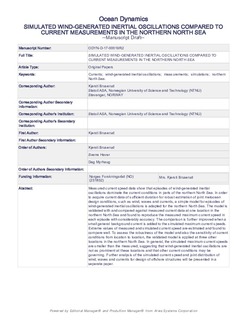| dc.contributor.author | Bruserud, Kjersti | |
| dc.contributor.author | Haver, Sverre | |
| dc.contributor.author | Myrhaug, Dag | |
| dc.coverage.spatial | North Sea | nb_NO |
| dc.date.accessioned | 2018-10-05T14:00:47Z | |
| dc.date.available | 2018-10-05T14:00:47Z | |
| dc.date.created | 2018-04-25T10:34:01Z | |
| dc.date.issued | 2018-06 | |
| dc.identifier.citation | Bruserud, K., Haver, S., Myrhaug, D. (2018) Simulated wind-generated inertial oscillations compared to current measurements in the northern North Sea. Ocean Dynamics. 68(6), pp. 645-661. | nb_NO |
| dc.identifier.issn | 1616-7341 | |
| dc.identifier.uri | http://hdl.handle.net/11250/2566719 | |
| dc.description | This is a pre-print of an article published in Ocean Dynamics. The final authenticated version is available online at: https://doi.org/10.1007/s10236-018-1150-z | nb_NO |
| dc.description.abstract | Measured current speed data show that episodes of wind-generated inertial oscillations dominate the current conditions in parts of the northern North Sea. In order to acquire current data of sufficient duration for robust estimation of joint metocean design conditions, such as wind, waves and currents, a simple model for episodes of wind-generated inertial oscillations is adapted for the northern North Sea. The model is validated with and compared against measured current data at one location in the northern North Sea and found to reproduce the measured maximum current speed in each episode with considerably accuracy. The comparison is further improved when a small general background current is added to the simulated maximum current speeds. Extreme values of measured and simulated current speed are estimated and found to compare well. To assess the robustness of the model and also the sensitivity of current conditions from location to location, the validated model is applied at three other locations in the northern North Sea. In general, the simulated maximum current speeds are smaller than the measured, suggesting that wind-generated inertial oscillations are not as prominent at these locations and that other current conditions may be governing. Further analysis of the simulated current speed and joint distribution of wind, waves and currents for design of offshore structures will be presented in a separate paper. | nb_NO |
| dc.language.iso | eng | nb_NO |
| dc.publisher | Springer | nb_NO |
| dc.subject | currents | nb_NO |
| dc.subject | wind-generated inertial oscillations | nb_NO |
| dc.subject | simulations | nb_NO |
| dc.subject | Nordsjøen | nb_NO |
| dc.subject | havstrøm | nb_NO |
| dc.title | Simulated wind-generated inertial oscillations compared to current measurements in the northern North Sea | nb_NO |
| dc.title.alternative | Simulated wind-generated inertial oscillations compared to current measurements in the northern North Sea | nb_NO |
| dc.type | Journal article | nb_NO |
| dc.description.version | submittedVersion | nb_NO |
| dc.subject.nsi | VDP::Teknologi: 500::Marin teknologi: 580::Offshoreteknologi: 581 | nb_NO |
| dc.source.pagenumber | 645-661 | nb_NO |
| dc.source.volume | 68 | nb_NO |
| dc.source.journal | Ocean Dynamics | nb_NO |
| dc.source.issue | 6 | nb_NO |
| dc.identifier.doi | 10.1007/s10236-018-1150-z | |
| dc.identifier.cristin | 1581505 | |
| cristin.unitcode | 217,8,5,0 | |
| cristin.unitname | Institutt for maskin, bygg og materialteknologi | |
| cristin.ispublished | true | |
| cristin.fulltext | preprint | |
| cristin.qualitycode | 1 | |
